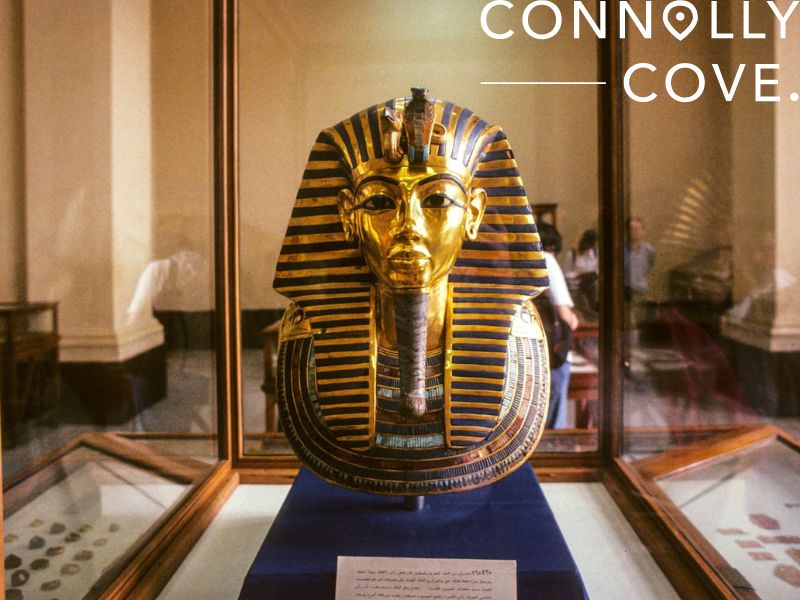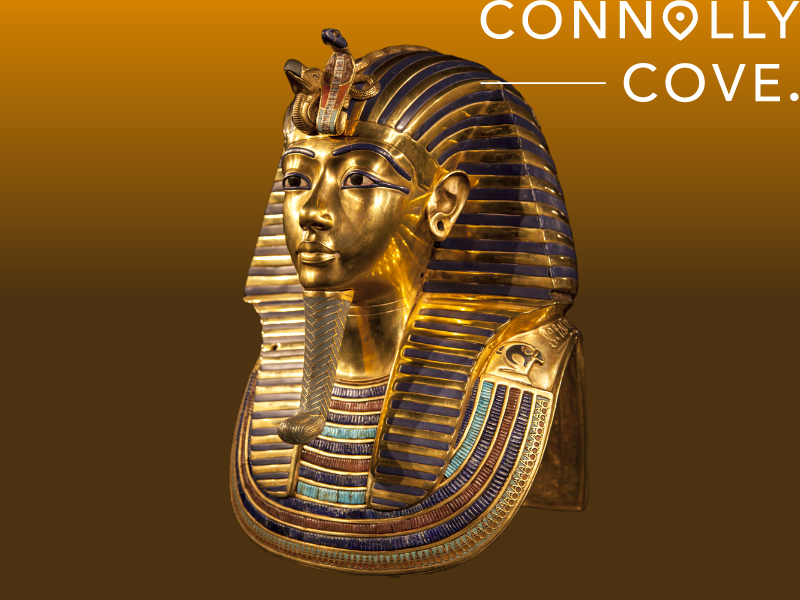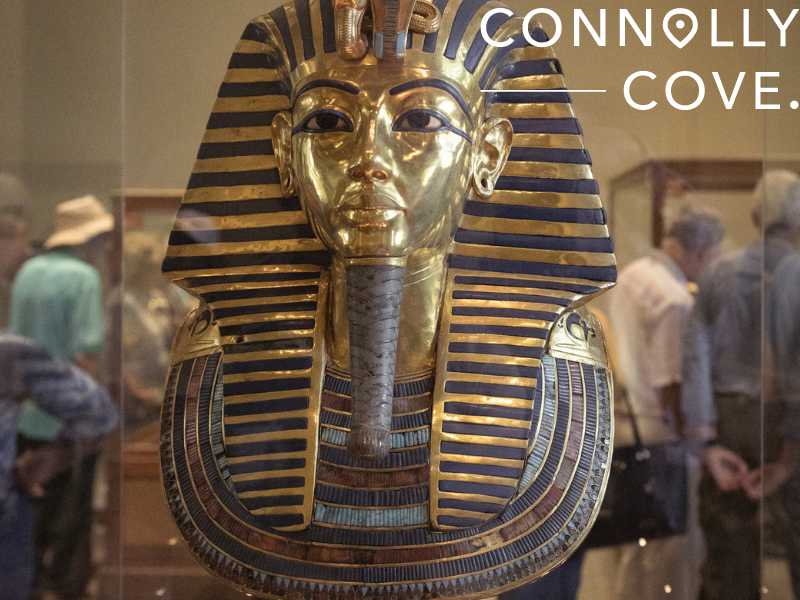Tomb of Tutankhamun: The Treasure Story of the Boy King

Updated On: February 19, 2024 by Marwa Abdel Moniem
An ancient ruler of Egypt who died very young and is better known nowadays for his well-preserved tomb—that’s the Boy King, Tutankhamun. It is a story about power and wealth combined in the New Kingdom of ancient Egypt.
Over a hundred years ago, there was no known Egyptian pharaoh by the name of Tutankhamun. Not until 1922, when British Egyptologist Howard Carter discovered his tomb. The discovery of the tomb of Tutankhamun, aka King Tut, has unveiled many stories related to this pharaoh who ruled young and died young. In this article, we will tell you about King Tut and his tomb. So, let’s start exploring!
Table of Contents
Tutankhamun: A King at the Age of Nine

A king at the age of nine! What brought him to the throne, and how was he able to rule as a minor? Well, there is a story to that. This Boy King would not have done it without the help of advisers.
Known as the youngest pharaoh in the history of ancient Egypt, Tutankhamun remained an unknown ruler of the New Kingdom until his tomb was unearthed and accordingly was his name. He was brought back to life more than 3,300 years later.
During his ten years as a pharaoh, from 1332 to 1323 BC, Tutankhamun listened to advice from his Grand Vizier and, most likely, grandfather Ay. Horemheb was the commander-in-chief of the ancient Egyptian army back then, and he guided the young king through his rule.
His brave decisions helped restore the traditional religion with all the temples and old gods that had prevailed before his time. He even changed his name! Born Tutankhaten, the Boy King became known as Tutankhamun.
Tut in ancient Egypt was a male name that meant “image.” His father Akhenaten named him Tutankhaten, which translates into the image of Akhenaten. However, King Tut chose to be the image of the god Amun, abandoning his name of birth for Tutankhamun.
Under his rule, the New Kingdom returned to polytheism. Tutankhamun reversed all religious reforms that had been introduced by his father and restored the cult of Amun.
King Tut’s Wife and Sister!
King Tut had only one wife, whom he married shortly after his coronation. It is believed that his wife, Ankhesenamun, was also his half-sister. She was the daughter of Akhenaten and Nefertiti. Yes, Nefertiti was King Tut’s mother-in-law.
Together, King Tut and Ankhesenamun had two twin daughters: one was stillborn, and the other died shortly after birth. The two babies were buried with their father, who died at the age of 19 in 1324 BC.
King Tut’s Death
Identifying the cause of the death of King Tut could not be more complex. There is more than one theory, but to say for sure what indeed led to Tutankhamun’s death is not possible. The king died of an infected broken leg—that was the belief for many years before the question of malaria popped up. Around 130 walking sticks were found in King Tut’s tomb, which supports the theory of his leg injury.
Recent DNA tests, however, revealed that the boy king had traces of malaria in his remains and a bone disorder that triggered his early death. One other dissection of the mummified corpse of Tutankhamun shows that he had received a severe blow to the back of the head that likely caused his death.
While the cause of King Tut’s death remains uncertain, his passing away surely put an end to one of the powerful dynasties of ancient Egypt.
The Tomb of Tutankhamun
Welcome to tomb number KV62—the burial place of Tutankhamun in the Valley of the Kings in the Upper Egyptian city of Luxor. Discovered in 1922, Tutankhamun’s tomb was the 62nd to be found in the Valley of the Kings and was thus given the reference number KV62.
This tomb of the 18th Dynasty Boy King is the only royal burial found intact and provides insights into ancient Egypt. Hidden by debris for thousands of years, the tomb of Tutankhamun had not been plundered like most of the royal graves in ancient Egypt. That’s why it was very well preserved when unearthed by British archaeologist Howard Carter.
The tomb of King Tut is made up of four rooms, one being his burial chamber. The walls of this chamber are covered in gold. A three-layer coffin held in something like a stone container could be found in the burial chamber. The outermost coffin is red quartzite in colour, whereas the innermost is a mummy-shaped coffin that weighs about 110 kilograms of solid gold, and in it, the iconic golden mask of the boy king was found.
Full of priceless artefacts, a treasury room is also found inside the tomb of King Tut. About 5,000 items were recovered from the grave, including, of course, the golden mask and dagger.
Personal possessions were buried with the young king, including his throne, jewellery, furniture, chariots, and clothing. King Tut’s tomb contained hundreds of pairs of shoes, including his golden sandals. It was indeed one of the most essential excavation operations made in the history of archaeology.
Howard Carter: An Unforgettable Discovery & Looting of the Tomb of King Tut
Howard Carter was the first archaeologist to discover the burial place of the Boy King. He led the excavation in Luxor’s Valley of the King in 1922 and made this unforgettable discovery that brought him global acclaim.
It all started on 4 November when Carter and his crew came across a step as they were digging in the area. This was the first of 16 steps that led to the sealed doorway of the tomb of King Tut.
Inside the tomb, while in the process of unearthing the treasure, Carter significantly damaged the mummy. He and his team used hot knives to remove the golden mask from the head of the mummified king. Unfortunately, the mummy was beheaded and broken into more than 15 pieces before they were recollected back into position.
Years later, Bob Brier, an Egyptology professor at Long Island University, said Carter had undoubtedly stolen some of the jewellery of King Tut during the excavation in Luxor. Carter is believed to have broken into the grave of the Boy King before its official opening.
Revelations about King Tut
The golden mask of a handsome King Tut was indeed a mask that concealed a sick, deformed and even crippled young man who was the offspring of sibling marriage.
Digital images of the mummy of the Boy King and genetic analysis of his family have revealed some surprising facts—Tutankhamun had buck teeth and womanly hips.
The Dagger of King Tut
The iron dagger of King Tut was among the treasures found inside his tomb in the Valley of the Kings. The 34-cm-long dagger was decorated with gold. What is unique about this dagger is that its blade was made of crystallised metal similar to those found in some meteorites. The sword was discovered with the mummy of King Tut, which proves that he was a warrior.
The Mask of King Tut

The golden funerary mask of the 18th Dynasty king is a masterpiece of ancient Egyptian art. Made of two gold sheets that were hammered together, the mask was originally fitted on the shoulders of the mummy.
X-rays have proven archaeologists’ conclusions about the mask wrong. The scanned mask showed that it consisted of more than one part that was accurately welded and could not be seen with the naked eye.
The death mask of King Tut’s mummy features two images of the cobra and vulture, which represent unity between Lower and Upper Egypt.
Where Is It All Now?
Most of the items recovered from King Tut’s tomb are now exhibited at the Grand Egyptian Museum in Giza. The mummy of the Boy King, along with his sarcophagus, are still on display in the vault in Luxor.
The riches of King Tut remain unrivalled as they bring ultimate fascination to the beholders. Travelling collections of the treasures of the young pharaoh never fail to attract thousands of lovers of the ancient Egyptian civilisation. King Tut’s collection has already been displayed at exhibitions in Boston, Los Angeles, London, and Paris.
It is about time that you discover the tomb of King Tut yourself. Book your trip to the Valley of the Kings to get firsthand information about the young pharaoh. Besides King Tut’s tomb in Luxor, you will also need to inspect his treasure and personal belongings niched at the Grand Egyptian Museum in Giza. Remember, the treasure story of King Tut cannot only be told, it should also be seen!






